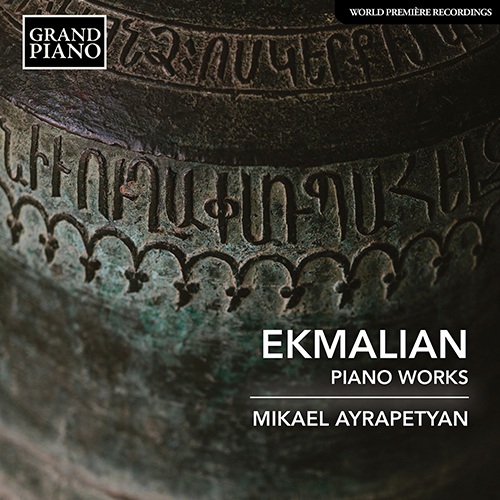
Makar Ekmalian (1856 - 1905)
Makar Grigori Ekmalian was an Armenian composer, conductor, teacher, folklorist, and a student of Rimsky-Korsakov. He played a significant role in the development of Armenian musical art of the 19th and 20th centuries.
Makar Ekmalian was born in Vagharshapat, Russian Empire (now Etchmiadzin, Armenia) to Western Armenian parents. In 1872 he graduated from the Theological Seminary of the Etchmiadzin Catholicosate. In 1873–74, in St Etchmiadzin, he studied ancient Armenian notography under the prominent composer and musicologist Nikoghayos Tashchian. Together with his teacher, Ekmalian recorded and standardised liturgical hymn books using Armenian notography, and participated in the publication of collections of sacred music. Catholicos George IV blessed the editions of ancient spiritual hymns, liturgical hymns and the chronology of the Armenian church prepared by Tashchian and Ekmalian. From 1874 Ekmalian taught singing and Armenian music theory at the Gevorgian Theological Academy.
Ekmalian’s primary education in local seminaries and colleges paved the way for his relocation to St Petersburg where he was enrolled at the St Petersburg Conservatory in 1879 and studied under Nikolay Rimsky-Korsakov, having received permission to study for free.
At the same time, he led the choir of the local Armenian Church of St Catherine, which facilitated his financial situation. This experience would go on to inform his studies and influence his work on the Patarag (‘Divine Liturgy’) of the Apostolic Church.
In 1887, during the student summer holidays, he went to St Etchmiadzin, where he presented excerpts from his Three-Voice Liturgy to Catholicos Makar I, and, having received the approval of the Synod, returned to St Petersburg. He graduated from the St Petersburg Conservatory in 1888, and his thesis – the cantata The Wanderings of the Rose, based on the fairy tale by German poet Moritz Horn – was performed under the composer’s direction.
During his student years, Ekmalian created several prominent piano pieces: Nocturne and Song Without Words, the romance My Tears based on the words of Heine, Shadows of High Mountains and By the rivers of Babylon. The creativity of Ekmalian played a fundamental role in the development of Armenian music: by significantly expanding its genre boundaries, the composer contributed to the formation of a new national musical language, and the introduction of the Armenian melos to European forms of polyphonic music.
In 1891, Ekmalian moved to Tiflis (now Tbilisi), and taught at the Nersisian Armenian seminary, where he created a first-class men’s chorus.
Ekmalian’s magnum opus is the monumental Patarag – a divine liturgy for a fourvoice mixed choir a cappella. Patarag is the name of the musical accompaniment of Christian worship in the Armenian church. The basis of the Patarag (originally translated from Greek) is an edition of the Eastern Christian Liturgy with a number of original inserts. In ancient times, recitative and psalmody prevailed in Patarag. Over time, more chanting forms of choral and solo singing began to develop. In the 12th century, the expressive means of the Patarag were updated and raised to a new artistic level by Nerses Shnorali, Catholicos of Armenia from 1166 to 1173. In the 19th century, numerous Patarags were created for choir using traditional melodic material. Chiefly among them, the Patarag of Ekmalian, and the polyphonictextured Patarag of his student Komitas, stand out. Ekmalian incorporates previously unheard polyphonic and homophonic vocal parts into the core structure of Patarag and notates it in its entirety. He completed the work in 1892. Ekmalian presented his creation for discussion to the St Petersburg Court Singing Chapel and the Conservatory, where the work was highly appreciated and recommended for performance and publication.
The Nersisian seminary school choir of Tiflis was the first to perform this novel version of the Patarag, which would influence the compositional approach to Armenian liturgical and folkloric music within the works of Komitas – himself a student of Ekmalian – and others. The work also received a performance in Vienna.
In 1893–94 Ekmalian became teacher and rector of the Tbilisi Music College. He was admired by composers including Balakirev, Verdi, Saint-Saëns and Komitas. Arrangements of peasant folk songs occupy a central place in Ekmalian’s creative work alongside his other works including symphonic overtures, choruses, romances and piano pieces. He died on 6 March 1905 in Tiflis.
Mikael Ayrapetyan


 Grand Piano has gained a reputation for producing high quality recordings of rare keyboard gems. Dedicated to the exploration of undiscovered piano repertoire, the label specialises in complete cycles of piano works by many lesser-known composers, whose output might otherwise have remained unknown and unrecorded.
Grand Piano has gained a reputation for producing high quality recordings of rare keyboard gems. Dedicated to the exploration of undiscovered piano repertoire, the label specialises in complete cycles of piano works by many lesser-known composers, whose output might otherwise have remained unknown and unrecorded.






